Choosing the right material for your jacket lining can be confusing. There are many options, each with different benefits and drawbacks. Most people want a lining that feels comfortable, looks good, and lasts long, but they don’t know where to start.
If you pick the wrong lining, your jacket could feel too hot, too cold, or even itchy. Some linings might not hold up well to frequent use or washing. You could end up spending more money or feeling disappointed with your purchase.
To choose the right material for your jacket lining, focus on comfort, durability, and how you plan to use the jacket. This blog will guide you step by step to make a smart and satisfying choice for your next jacket.
Key Takeaways
- Consider the climate—choose thick, insulated linings for cold weather and lightweight, breathable fabrics for warm or active use.
- Match the lining material to your desired level of comfort, durability, and moisture management.
- Select materials that complement the jacket’s style and function, such as silk for formal wear or polyester for everyday durability.
- Factor in care requirements; opt for easy-care synthetics if you prefer low-maintenance garments.
- Prioritize sustainability by selecting eco-friendly options like recycled polyester or cupro when possible.
Understanding the Purpose of Your Jacket
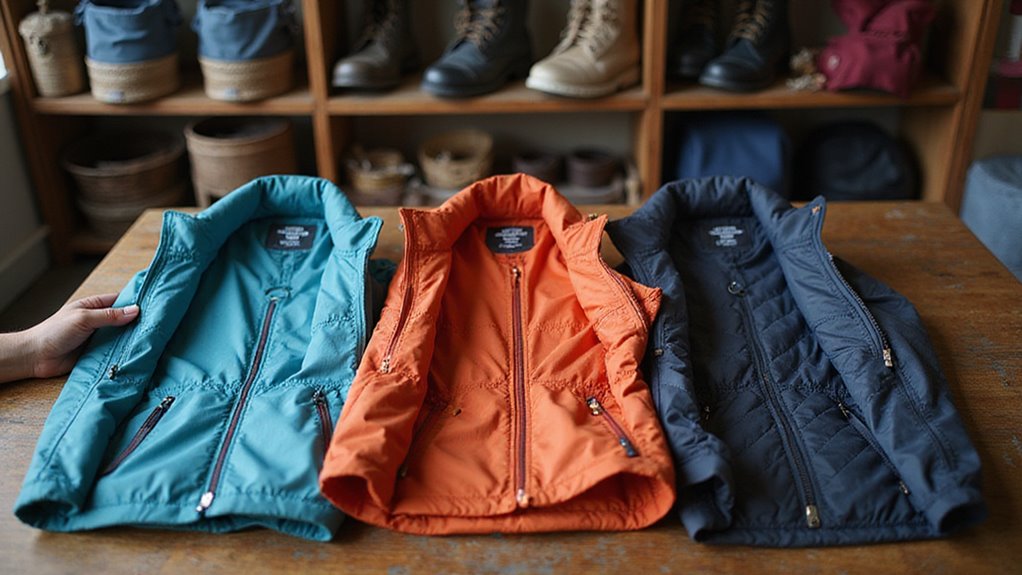
The jacket’s purpose will guide your lining choice. Decide if you need warmth, breathability, durability, or moisture control. Consider where you will wear the jacket, such as cold, wet, or changing weather. If you need moisture control, choose synthetic linings. Pick insulated linings if warmth is most important. Bulky linings can limit movement or change the jacket’s shape.
Sleek linings give a better fit and comfort. Some linings work better with extra or hidden pockets. By knowing your needs, you can pick the best lining for both function and style. Drawing inspiration from high-quality mockups, you can also ensure your lining choice visually complements the overall sophistication and purpose of your jacket. Incorporating realistic product previews can further aid your decision by allowing you to see how different linings will look and function before committing to a final design.
Key Factors to Consider When Selecting a Lining
When you select a jacket lining, prioritize breathability and tactile comfort to ensure optimal wearability. Assess the fabric’s abrasion resistance and structural integrity for long-term durability. Factor in thermal regulation and moisture management to match the lining with your target climate and season.
Adding a lining can also extend the jacket’s lifespan and enhance its professional appearance. For additional assurance, consider using lining mockups to experiment with different materials and designs before finalizing your choice, allowing for thorough testing of comfort, durability, and overall garment quality.
Breathability and Comfort Level
Breathable and comfortable linings make jackets pleasant to wear. Good linings use materials like cupro, viscose, or lightweight cotton. These fabrics allow air to flow and help move sweat away from your skin. If you choose these materials, your jacket will feel cooler and less stuffy.
Smooth linings also help jackets slide easily over other clothes. If you want extra style, pick linings with nice colors that match or contrast with your jacket. The right lining improves both comfort and appearance.
Durability and Wear Resistance
A jacket lining must be durable and resist wear from regular use. Synthetic materials like polyester and nylon last longer than natural fibers. These synthetics resist abrasion and are hard to tear. Polyester and nylon keep their shape after frequent rubbing or stretching.
Natural fibers, such as cotton and silk, feel soft but wear out faster. Cotton and silk may pill, snag, or thin with daily use. If you want a longer-lasting jacket, choose synthetic linings. Consider synthetic options if your jacket faces frequent movement or pressure.
Climate and Seasonal Suitability
Jacket linings help control warmth and comfort. Choose thick linings like quilted polyester or wool blends for cold weather. These materials trap heat with little bulk. If you need a jacket for warm seasons, select lightweight linings. Bemberg rayon or mesh allow air to flow and manage sweat.
Fabric dyes can affect breathability and color. Some dyes make linings less able to wick moisture, especially in humid places. Smooth satin linings feel cool, while brushed finishes add warmth. Match lining materials and patterns to your weather needs for best comfort and look.
Silk: The Classic Choice for Luxury
Silk is a top choice for luxury jacket linings. This fabric has a smooth shine and feels soft to the touch. It is very light and drapes well, so jackets look neat and tailored. Silk also allows air to flow, keeping you cool and comfortable. If you want a jacket that feels cool and moves easily, silk is a good option. The fiber is strong for its weight and does not tear easily. Silk helps manage moisture and keeps sweat away from your skin.
If you choose silk, you get both comfort and a touch of elegance. Many people pick silk for formal jackets and custom-made clothing. For those interested in visualizing how their jacket design might look, using a customizable mockup template can offer a realistic preview before production. In addition, silk linings can be showcased effectively with realistic visuals in mockups to impress clients and highlight the fabric’s natural luster.
Satin: Smoothness and Versatility
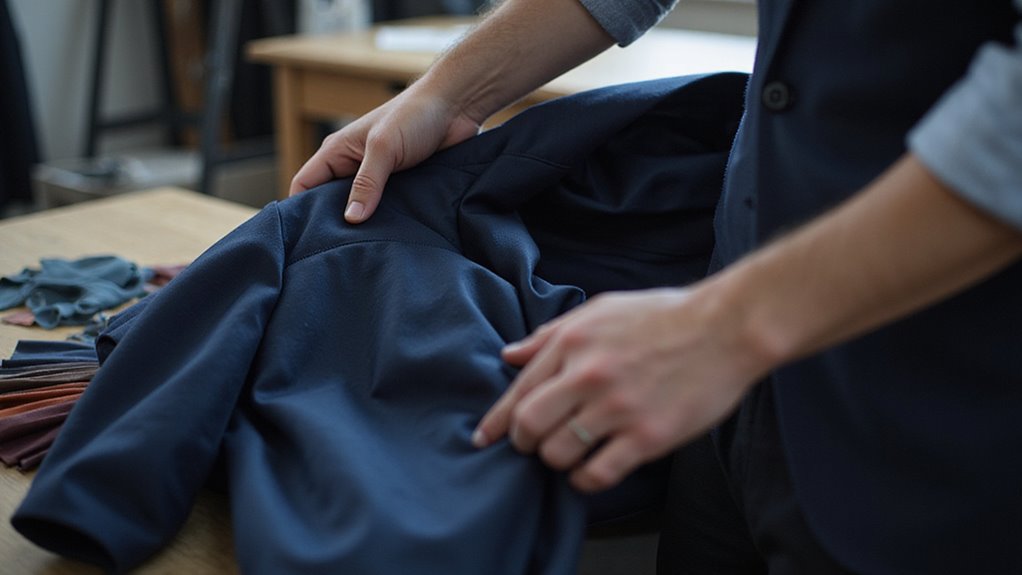
Satin is a smooth and shiny fabric often used for jacket linings. The glossy surface makes jackets look more elegant. Satin’s tight weave gives it a soft touch and allows jackets to slide on easily. This fabric is popular because it works well in both formal and casual jackets. You can choose different colors and thicknesses to match your jacket’s style. If you want a lining that looks good and feels comfortable, satin is a strong choice.
Just like how high-quality, detailed PSD catalog mockups can elevate a design project, choosing a refined satin lining can enhance the overall look and professionalism of your jacket. Satin’s popularity in fashion is also due to its role in enhancing visualization during the design process, helping designers and clients better imagine the final product.
Polyester Linings: Durability and Affordability
When you select polyester linings, you’re prioritizing tensile strength and abrasion resistance that hold up to frequent wear. Manufacturers favor polyester for its cost-effective production and consistent quality across large batches. You’ll also benefit from its inherent moisture-wicking properties, which improve comfort during extended use.
Polyester linings are a popular choice for year-round staples in jackets because they offer durability and adaptability across different seasons. Additionally, polyester’s customizable qualities make it easy to adapt to various branding or design needs, aligning with modern industry standards for versatility.
Strength and Wear Resistance
Polyester linings are strong and resist wear well. This makes them a popular choice for clothing that needs to last. Polyester’s tight weave helps prevent snags and tears. This is especially helpful in places like sleeves and hems. The color of polyester linings stays bright, even after many washes. The fabric also keeps its shape over time.
Here’s a quick comparison:
| Attribute | Polyester Lining | Silk Lining | Cotton Lining |
|---|---|---|---|
| Tensile Strength | High | Moderate | Low |
| Abrasion Resistance | Excellent | Poor | Moderate |
| Color Retention | Superior | Moderate | Poor |
Cost-Effective Production Choice
Polyester is a cost-effective choice for jacket linings. It is both durable and affordable. Large-scale production keeps its material costs low. Polyester linings offer a smooth and uniform look. These linings help brands lower production expenses.
Polyester resists creasing and is easy to care for. This reduces handling and maintenance costs after production. Manufacturers choose polyester because it performs well during cutting and sewing. If you need value and quality, polyester is a reliable option.
Moisture Management Qualities
A polyester lining manages moisture well in daily use. Its synthetic fibers pull sweat away from your skin. This helps the fabric dry quickly and keeps you comfortable. If extra protection is needed, polyester can be made waterproof and still allow air to pass through.
| Feature | Polyester Lining Performance |
|---|---|
| Moisture Wicking | High—moves sweat away from skin |
| Waterproof Capability | Possible with special membrane layers |
| Drying Time | Quick—absorbs little water |
| Comfort in Wear | Smooth surface reduces friction |
Cotton Linings: Breathability and Comfort
Cotton linings offer good breathability and comfort for jackets. Cotton fibers allow air to move through the fabric easily. This helps keep the inside of the jacket cool and prevents sweat buildup. Cotton feels soft against the skin and is gentle for people with sensitive skin. It also resists static, making it comfortable to wear. If you want more durability, choose tightly woven or mercerized cotton. Cotton linings hang well and do not cling to the body.
The fabric takes dye well, so you can choose from many colors or patterns. Cotton linings are a good choice if you need comfort and versatility in your jacket. Additionally, cotton linings are easy to clean, making them a practical option for those who want low-maintenance jacket care. Designers can use professional presentations to showcase a jacket’s interior features, such as cotton linings, to help clients visualize both comfort and style.
Flannel Linings: Warmth for Cold Weather
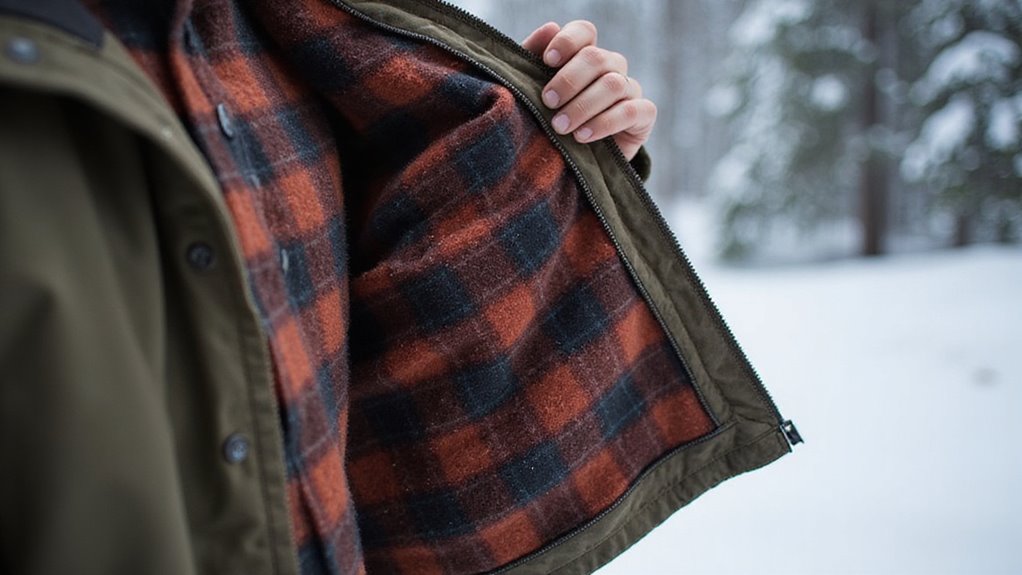
When you choose flannel linings, you’re prioritizing thermal insulation through densely woven, brushed fibers that trap body heat efficiently. You’ll notice the soft nap provides a gentle feel against the skin, minimizing abrasion and enhancing comfort for extended wear. This combination of heat retention and tactile softness makes flannel ideal for jackets designed for cold-weather environments.
Flannel linings can also be easily visualized and customized within layered PSD files, allowing designers to showcase their warmth and texture in digital mockups before production. Designers can benefit from the pre-designed, high-resolution templates available for Photoshop, which speed up the workflow and ensure the flannel lining’s appearance is professional and visually appealing in presentations.
Insulation Properties Explained
A jacket’s lining is the main factor that keeps you warm in cold weather. Flannel lining provides good insulation and helps manage moisture. It has tightly woven fibers that trap air and hold in body heat. At the same time, it lets sweat escape, so you stay dry inside your jacket. This helps keep you warm without making you sweat too much.
If you are checking flannel linings, look for these features:
- Flannel’s brushed surface creates a thick layer that traps air for better warmth.
- Its natural fibers pull moisture away from your skin to keep you dry.
- Flannel helps keep your body temperature stable, so you do not feel too hot or too cold.
Comfort Against Skin
Flannel feels soft and warm against the skin. Its brushed cotton surface reduces irritation and keeps you comfortable. Flannel linings trap air, which helps keep you warm in cold weather. If you choose a thicker lining, you will get more warmth but less breathability. Thinner linings are lighter and allow more air flow. Color coordination between the jacket and lining improves style and the look of warmth. Select flannel thickness and color to match your comfort and style needs.
| Lining Thickness | Comfort Level | Color Coordination |
|---|---|---|
| Thin | Moderate | Subtle contrast |
| Medium | High | Harmonized tones |
| Thick | Maximum | Bold or matching colors |
Viscose and Rayon: Softness and Sustainability
A jacket with viscose or rayon lining feels smooth and comfortable. These fibers come from plant cellulose and are partly man-made. Viscose and rayon are soft and gentle on the skin. They also wick away moisture, keeping you dry and fresh.
- Fiber Blending: Some manufacturers mix viscose or rayon with polyester or cotton to make the lining stronger and last longer.
- Eco Friendly Options: You can choose linings labeled Lenzing™ or certified sustainable viscose if you want a greener option.
- Visual Appeal: Viscose and rayon linings have a shiny look and move well, making the jacket’s inside look attractive.
Choosing the right lining material is just as important as selecting the jacket style, since both influence comfort, appearance, and suitability for different occasions.
Mesh Linings: Enhanced Airflow for Activity

Mesh linings help jackets breathe better during activity. These linings use open-weave fabrics like polyester or nylon. The tiny holes let heat and sweat escape quickly. If you move a lot, this keeps you cool and dry. Mesh linings are light and do not add bulk. The fabric dries fast, so it is good for sports or outdoor use. If you want more airflow instead of warmth, choose a mesh lining. This design works best when you need comfort and movement.
Quilted Linings: Extra Insulation for Harsh Conditions
Quilted linings add extra insulation for very cold weather. They keep you warm by trapping air between stitched layers and insulation. The quilted design stops cold spots and helps the jacket keep its shape. Common stitching patterns include diamond, box, or channel shapes, each made for warmth and durability.
You should pick quilted linings if you need:
- Good heat retention in freezing conditions.
- Strong structure that keeps insulation in place.
- Lasting comfort after many uses and washes.
If you expect harsh, cold weather, quilted linings are the best choice.
Leather and Faux Leather Linings: Unique Texture and Style
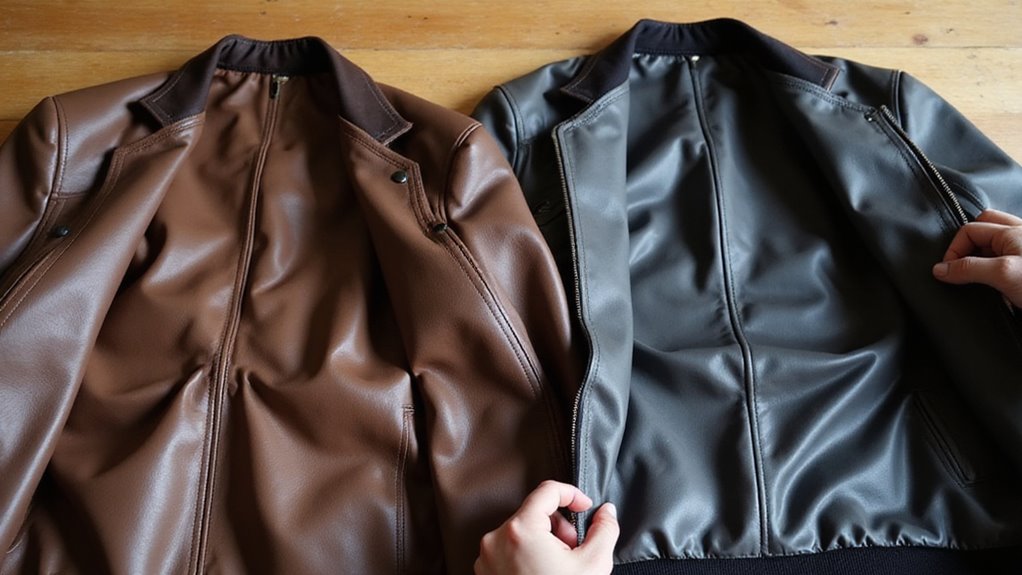
Leather and faux leather linings give jackets a special look and feel. Leather linings feel soft and smooth against the skin. Faux leather provides a similar texture and shine but is animal-free. Both materials help the jacket keep its shape and resist wrinkles. They also add a clean, structured finish to the inside.
If you want a lighter jacket, consider other linings, as these can be heavy. Breathability is lower with leather and faux leather linings. If comfort is your priority, you may want a different material. These linings stand out and can turn the inside of a jacket into a key design feature.
Matching Lining Color and Pattern to Your Jacket
Matching the lining color and pattern to your jacket helps create a balanced look. Choose a lining color that complements or contrasts the jacket’s outer fabric. If the jacket is formal, select a subtle, small pattern for the lining.
If the jacket is casual, larger or bolder patterns can work well. Match the lining’s pattern complexity to the jacket’s fabric texture. If you want a cohesive style, keep the colors similar; if you want a bold look, pick contrasting shades.
Caring for Different Lining Materials
You’ll need to adjust your care routine based on whether your lining is pure silk or a synthetic blend, as improper washing can cause fiber distortion or color bleeding. To minimize abrasion and prevent premature wear, always use wide, contoured hangers and avoid overloading closet space. Store your lined jackets in a cool, dry environment to preserve fabric integrity and prevent moisture-related damage.
Washing Silk Versus Synthetics
Silk and synthetic linings need different washing methods to last longer. Silk is delicate and needs gentle care. Synthetics are tougher and easier to clean.
If you have a silk lining, use cool water and a mild, pH-neutral detergent. Always wash silk by hand and avoid strong scrubbing. For synthetic linings, choose a gentle machine cycle and low heat. Synthetics can handle more movement and temperature than silk.
It is best to air dry both types, laying them flat. This prevents stretching or damage. Always read the care label before cleaning. Following these steps keeps linings looking and feeling good.
Preventing Lining Wear
To prevent jacket lining wear, reduce friction and moisture during use. Friction under arms and at seams can cause pilling. Wear smooth shirts and avoid keeping rough objects in jacket pockets. Moisture from sweat can discolor or distort lining, especially in bright or light colors.
Always let your jacket air out after wearing it. Airing helps remove trapped humidity and prevents mold or odor. If you use the jacket often, consider reinforcing high-use areas. Choose linings with a higher denier for better durability. Check regularly for thinning or fraying and repair small issues early.
Storing Lined Jackets
Proper storage helps lined jackets last longer. Jackets need good support and a safe environment to protect their linings. Delicate fabrics like silk, viscose, or cupro need special care. Use the following tips to store lined jackets well:
- Shaped, padded hangers support the shoulders and keep the lining from stretching.
- Breathable garment bags let air flow and stop moisture from building up inside.
- Cool, dry, and dark places protect jackets from light and dampness.
If you follow these steps, your lined jackets will stay in good shape for many seasons.
Balancing Style, Function, and Budget
Jacket lining affects both how the jacket looks and performs. You should consider style, comfort, and cost when choosing. Materials like recycled polyester and cupro are popular for being eco-friendly and stylish. Silk feels smooth and luxurious but is more expensive. Polyester blends are durable and cost less. Cupro is breathable and good for the environment. If you want to balance your needs, use the table below:
| Feature | Benefit/Consideration |
|---|---|
| Eco friendly | Better for the environment |
| Silk | Shiny and soft |
| Polyester blend | Tough and affordable |
| Cupro | Breathable and sustainable |
Proper lining choice helps match your style, comfort, and budget.
Conclusion
If you consider your needs, you can choose the right material for your jacket lining. If you want warmth, opt for thicker fabrics like flannel or quilted cotton. If you need breathability, materials such as silk or viscose are better choices.
If you care about maintenance, choose polyester or nylon for easy cleaning. If you prioritize style, select a lining color that complements your jacket’s exterior. If you want a longer-lasting garment, always check the durability of your chosen lining.
If you want to see how different linings look in your design, try Custom Mockup. Custom Mockup can help you visualize your jacket with various lining options. Use this tool to make a confident and informed decision for your next project.

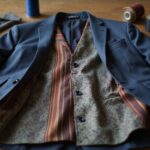

No Comment! Be the first one.